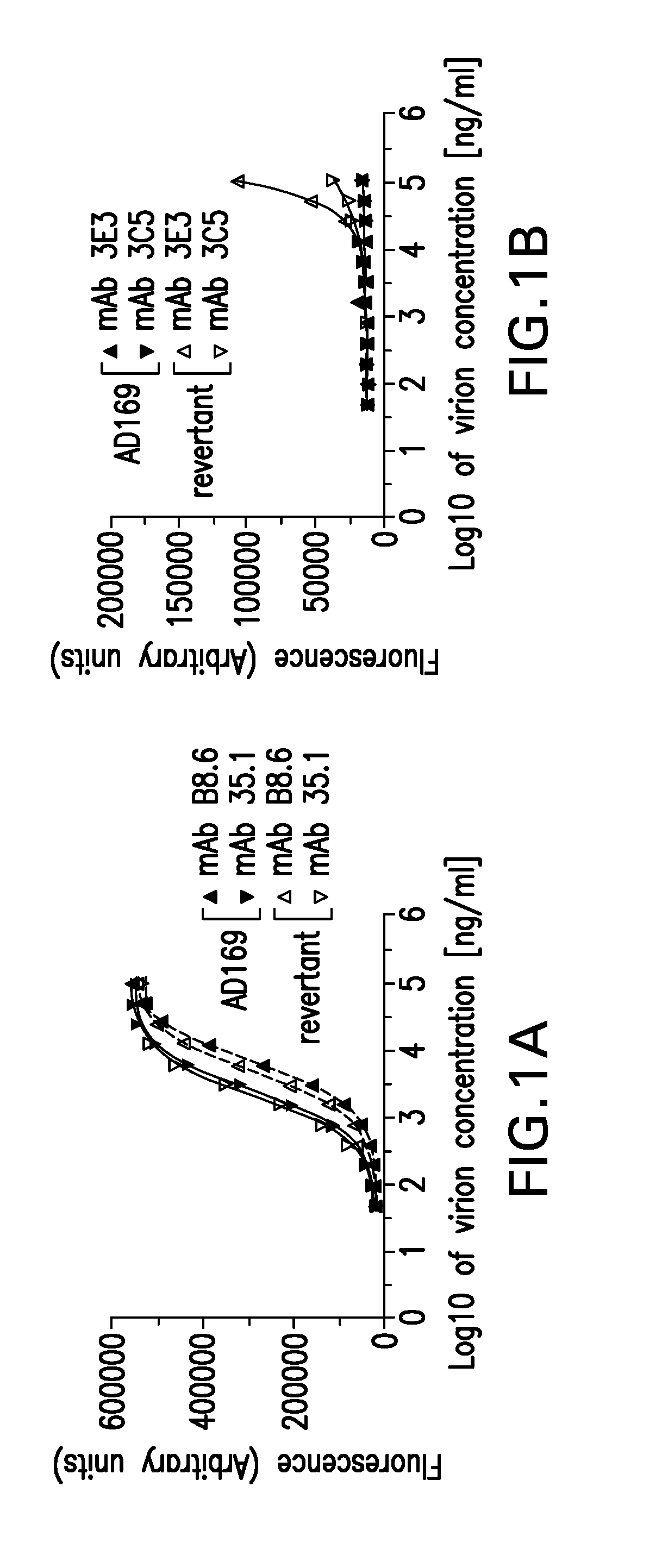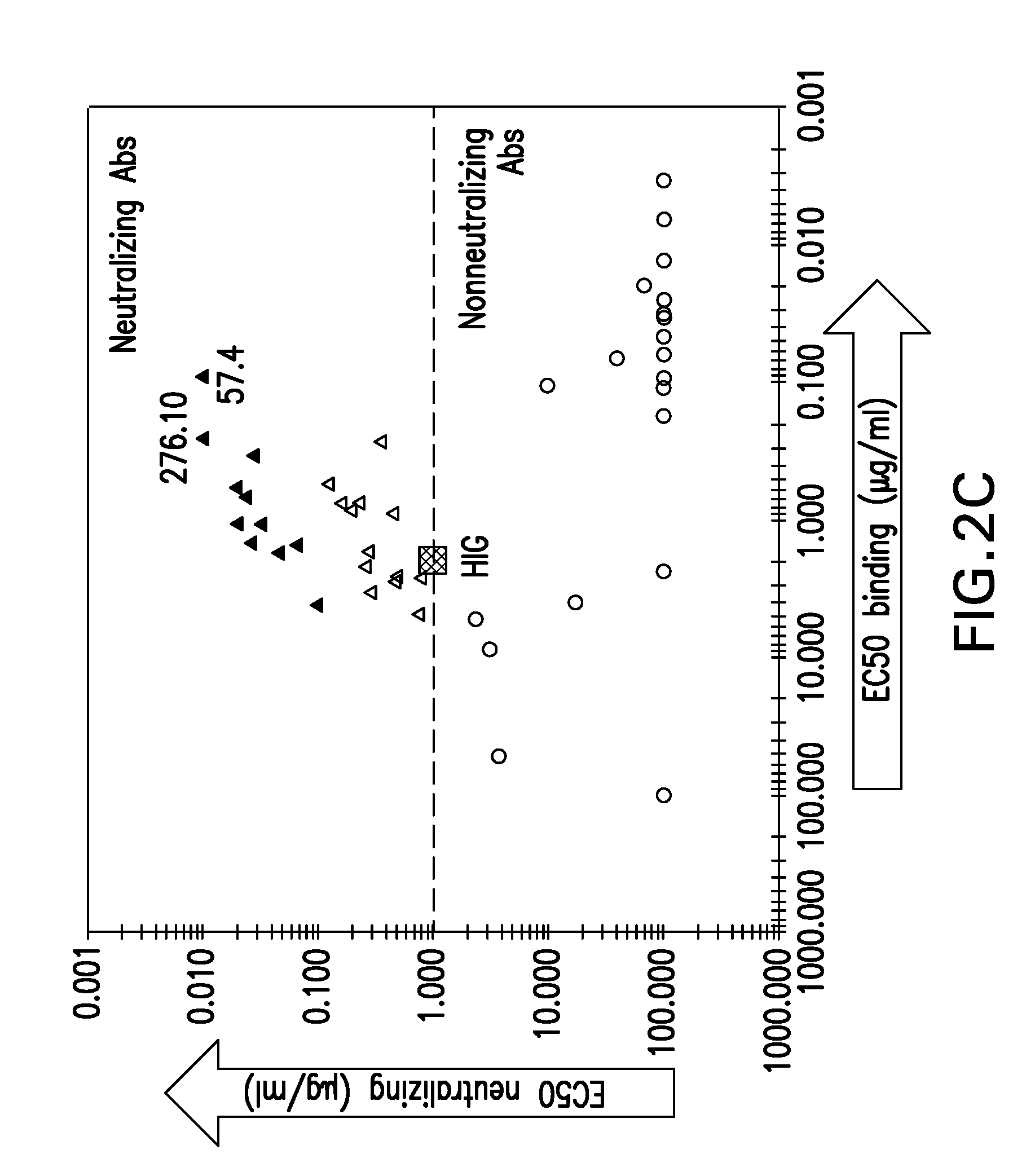Cmv neutralizing antigen binding proteins
- Summary
- Abstract
- Description
- Claims
- Application Information
AI Technical Summary
Benefits of technology
Problems solved by technology
Method used
Image
Examples
example 1
Generating a Panel of Rabbit Monoclonal Antibodies
[0268]The expression of the pentameric gH complex in AD169 was restored and the revertant virus was capable of infecting both MRC-5 and ARPE-19 cells. AD169 from ATCC (GenBank Accession No. X17403) was propagated in MRC-5 cells (Fu et al., 2012, Vaccine 30: 7469-7474; Tang et al., 2011, Vaccine 29: 8350-8356). The revertant virus was generated by serial passage adaptation of AD169 in culture as described in Fu et al. (2012, Vaccine 30: 7469-7474) and Tang et al. (2011, Vaccine 29: 8350-8356). AD169 virus and its revertant isolate were expanded in MRC-5 (ATCC Accession No. CRL-171) or ARPE-19 (ATCC Accession No. CRL-2302), respectively.
[0269]The revertant virus and its parental AD169 virus both contain the same levels of gB as determined using antigen titration enzyme-linked immunoassay (EIA). FIG. 1A shows that gB monoclonal antibodies B8.6 (IgG2aκ) and 35.1 (IgG2aκ) (both developed internally) reacted comparably to both viruses. In ...
example 2
Binding and Neutralizing Profiles of the Anti-CMV Monoclonal Antibodies
[0272]The monoclonal antibodies were assayed for their neutralizing and virus-binding and neutralizing capacities. The neutralization assay evaluated the ability of the monoclonal antibody to prevent viral epithelial cell entry. The virus-binding assay evaluated the ability of the monoclonal antibody to bind virions using ELISA.
[0273]Briefly, the neutralization assay used was based on enumeration of cells expressing viral immediate early (IE) antigen 24 hours post-infection and was described previously (Tang et al., 2011, Vaccine 29:8350-6). EC50 values, defined as antibody concentration required to block 50% viral entry, were calculated from four-parameter curve fitting using Prism® 5 (GraphPad® Software, San Diego, Calif.).
[0274]Briefly, the virus-binding assay used was an antibody-titration enzyme-linked immunoassay (EIA) to determine the relative binding affinity of each monoclonal antibody to the revertant v...
example 3
Neutralizing Capacity of an Antibody in Epithelial Cells does not Correlate with its Activity in Fibroblast Cells
[0280]It is known that HIG can block viral entry to fibroblast cells, such as MRC-5 cells, about 10- to 15-fold less effective at blocking viral entry to epithelial cells, i.e., ARPE-19 cells (Cui et al., 2008, Vaccine 26: 5760-5766). It has been implicated that viruses use different entry mechanism for infection of epithelial versus fibroblast cells (Wang et al., 2007, PNAS 104:20037-42). Thus, the panel of antibodies was evaluated by measuring the EC50 neutralizing in MRC-5 cells for each monoclonal antibody (Table 5). The correlation between EC50 values of an antibody to block virus entering MRC-5 cells (y-axis) versus ARPE-19 cells (x-axis) is shown in FIG. 3. All 45 antibodies can be categorized into three groups: antibodies in group A only neutralize virus in ARPE-19 cells, antibodies in group B neutralize virus in both cell types, while antibodies in group C are no...
PUM
 Login to View More
Login to View More Abstract
Description
Claims
Application Information
 Login to View More
Login to View More - R&D
- Intellectual Property
- Life Sciences
- Materials
- Tech Scout
- Unparalleled Data Quality
- Higher Quality Content
- 60% Fewer Hallucinations
Browse by: Latest US Patents, China's latest patents, Technical Efficacy Thesaurus, Application Domain, Technology Topic, Popular Technical Reports.
© 2025 PatSnap. All rights reserved.Legal|Privacy policy|Modern Slavery Act Transparency Statement|Sitemap|About US| Contact US: help@patsnap.com



